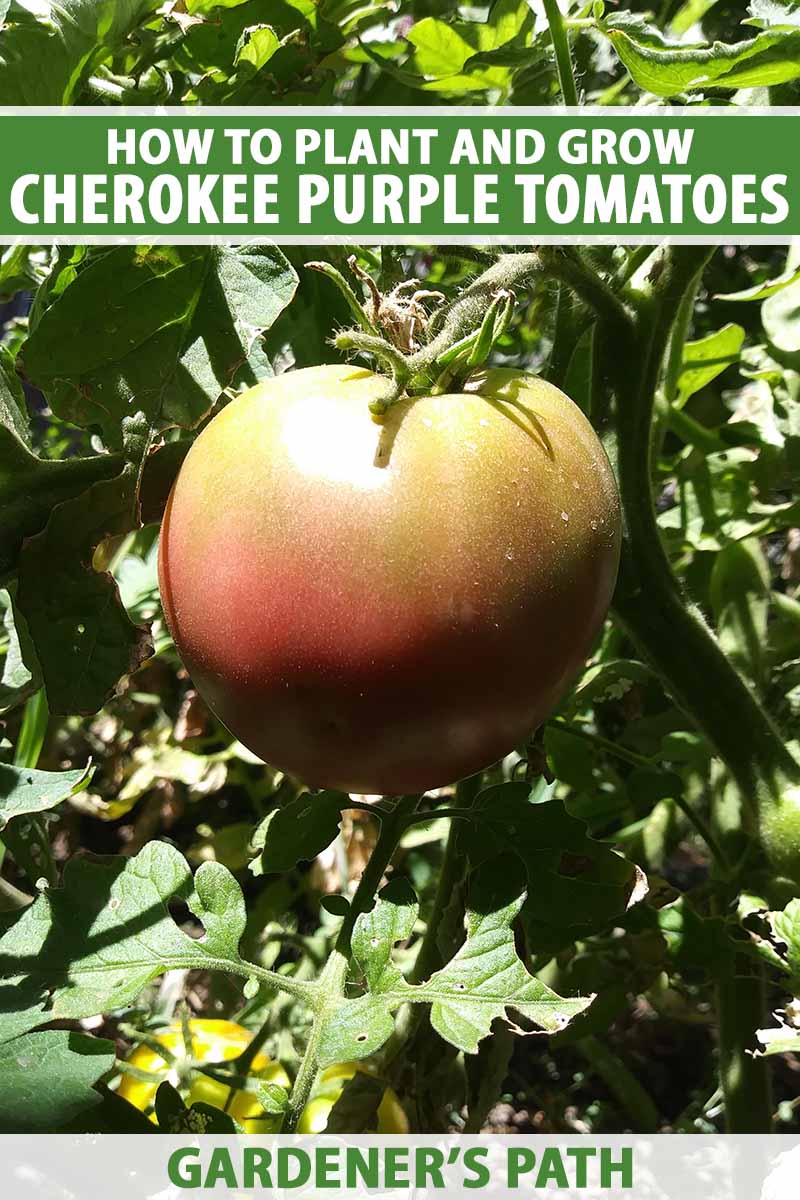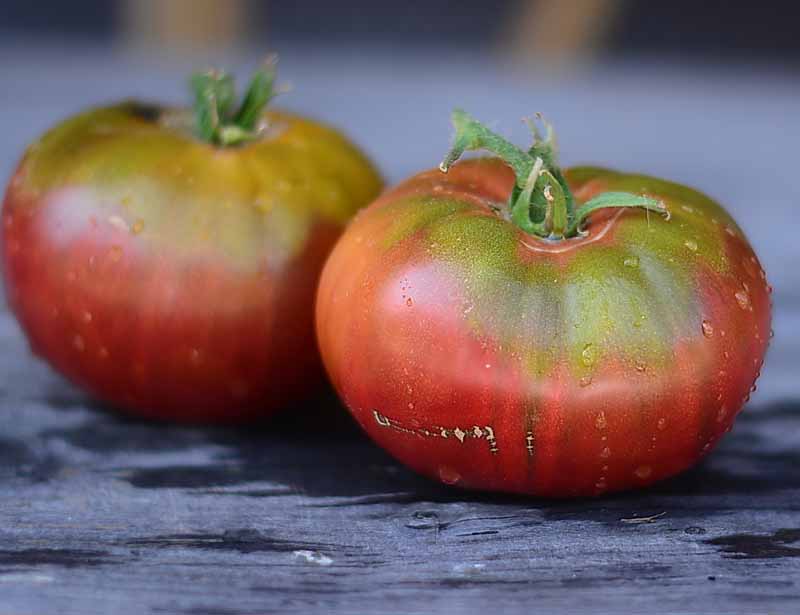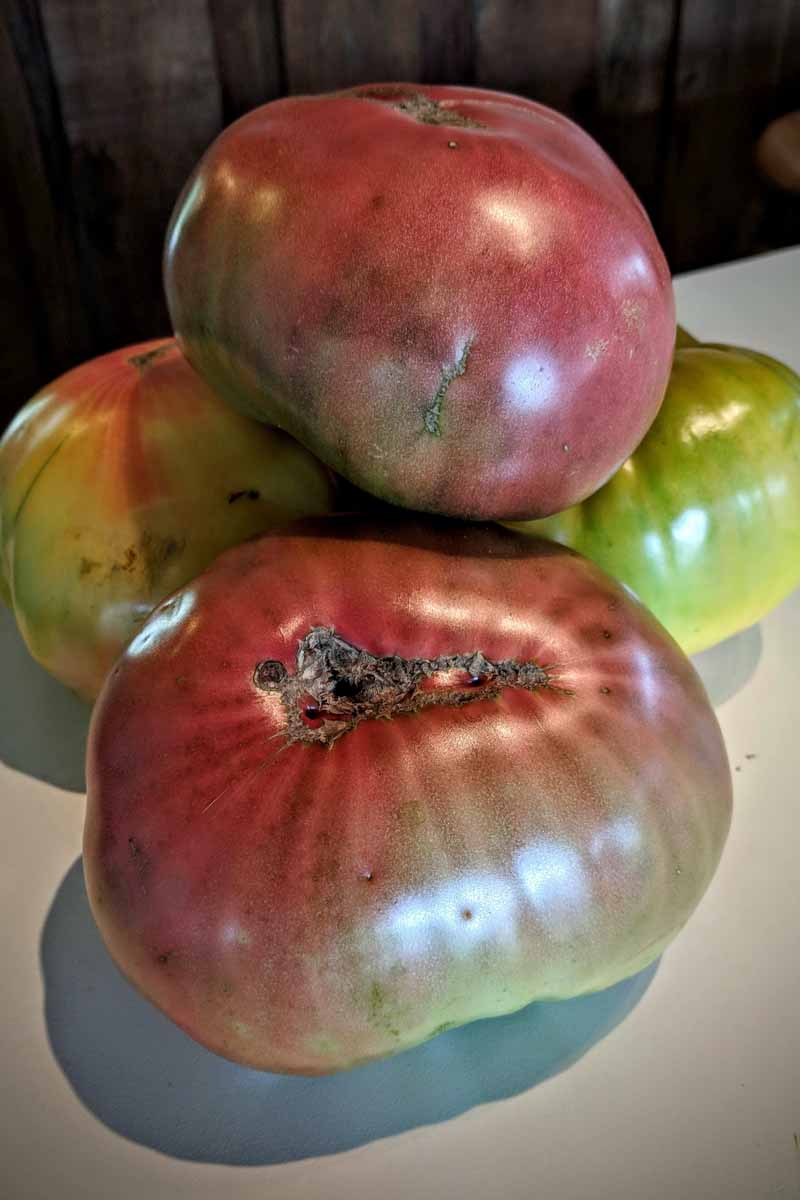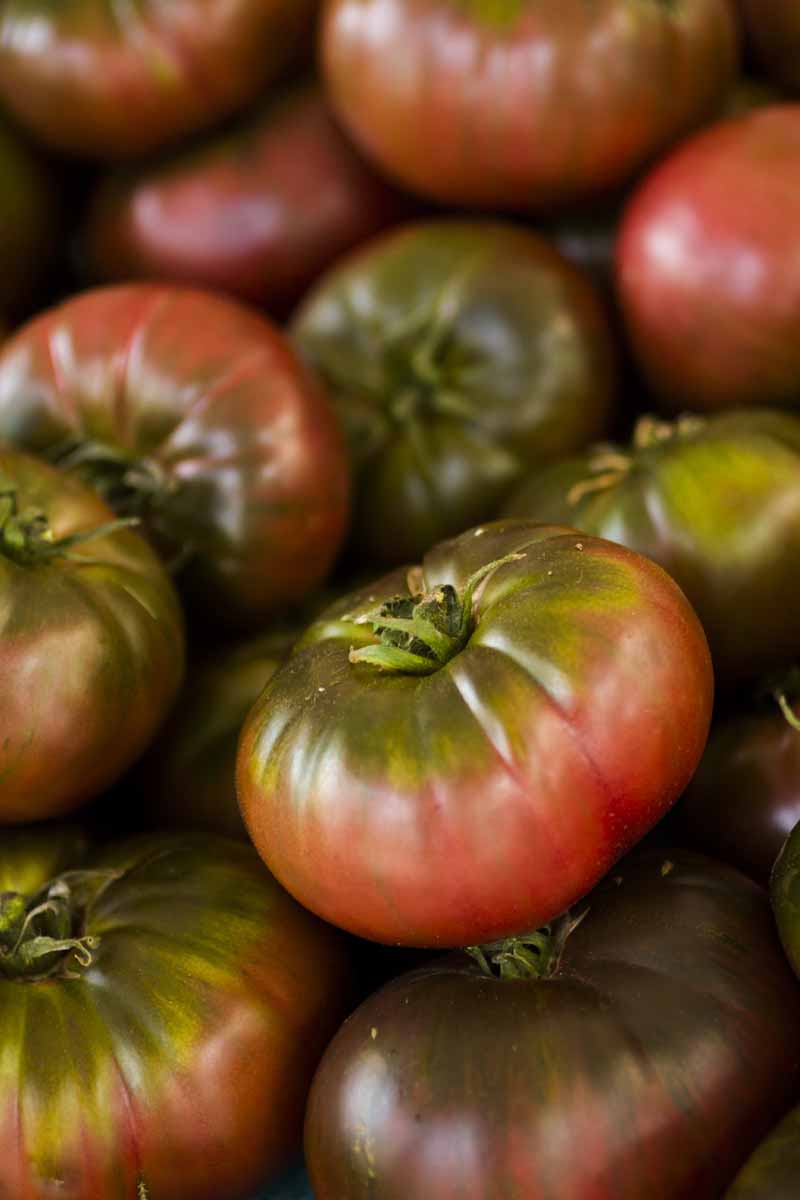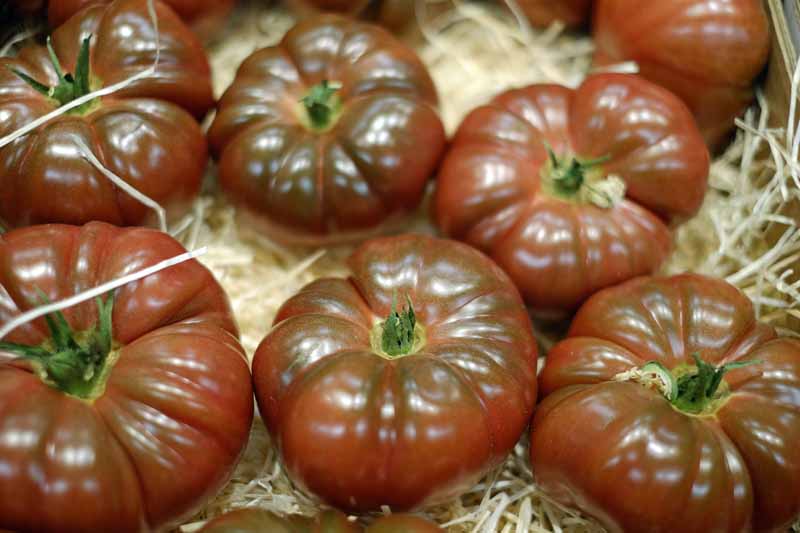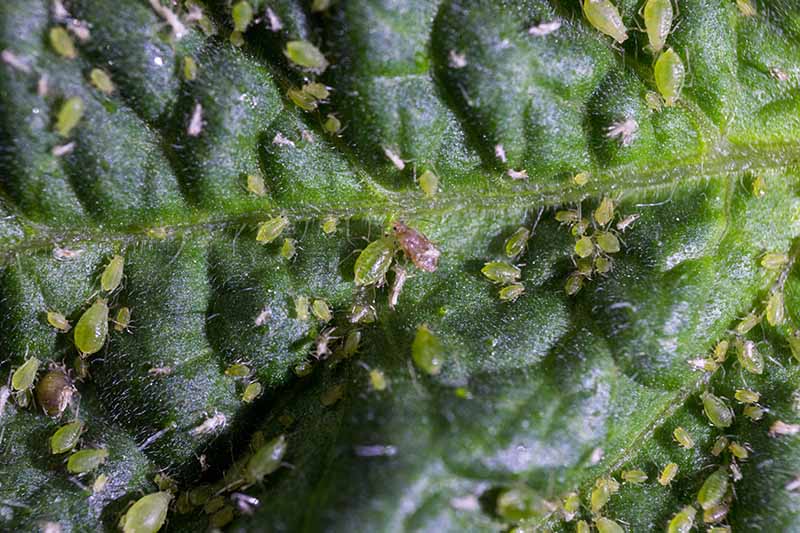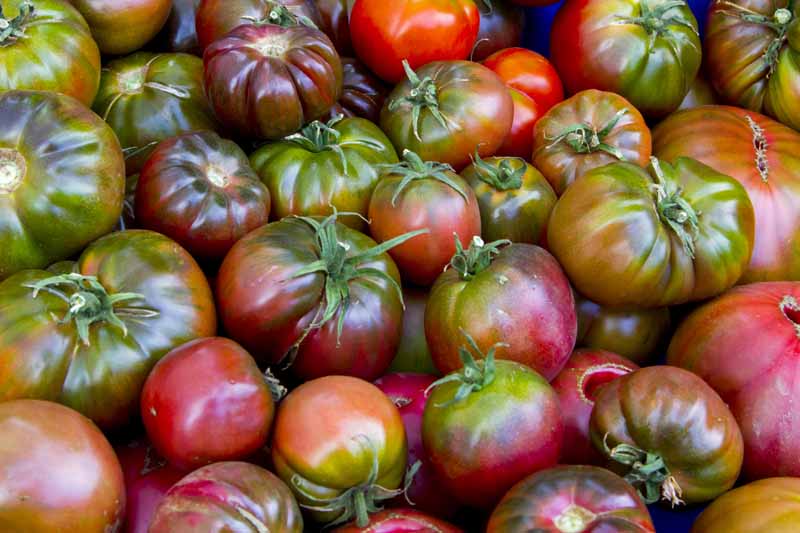Sizeable in both vine and fruit, this indeterminate heirloom can yield tomatoes weighing up to 12 ounces each! The bulbous fruit is blushed with purple-red skin, tinged with light green shoulders, and typically grows three to five inches in diameter. With a sweet yet smoky flavor, this little slice of tomato heaven is delicious in sandwiches or lightly grilled, and enjoyed as a pizza or pasta topping. We link to vendors to help you find relevant products. If you buy from one of our links, we may earn a commission.
What Is ‘Cherokee Purple’?
Great question! In one word… it’s delicious. In a few others… This is an old Cherokee heirloom with savory-sweet flavors and a unique appearance. Bulbous fruit with purple-pink flesh and deep red interior present a rich taste and juicy texture. The fruit is ready to harvest starting in 80 to 90 days. This cultivar has an indeterminate growth habit, meaning the plant grows and produces continually until it is killed by frost or some other external factor (as opposed to determinate growth which means plants are genetically predisposed to stop growing once their structure has formed completely). Open-pollinated, the seeds are genetically stable and will produce plants nearly identical to their parents. This quality, combined with the cultivar’s storied lineage, contributes to its characterization as an heirloom.
Cultivation and History
‘Cherokee Purple,’ the name given to this heirloom beefsteak, calls attention to its unique origin story as well as its characteristic purple-red hue. After years of being passed down from hand to hand, modern cultivation of this variety dates back to a particular seed exchange in 1990 between two tomato enthusiasts, John Green of Sevierville, Tennessee, and Craig LeHoullier of Raleigh, North Carolina. Inspired to share the gifts of this special tomato plant, Green sent a handwritten note and a packet of seeds to LeHoullier, a reputable seed saver and noted tomatoman. In his letter, Green explained that he had originally been given the seeds by a woman who received them from her neighbors. And they claimed this variety had been cultivated in their family garden for about 100 years after initially being gifted to them by members of the Cherokee tribe. Curious, LaHoullier planted the seeds and was so impressed by the results that he sent them along to friends at various seed companies, igniting the beginning of their commercial availability in the United States. In an interview between LeHoullier and Zachary Paige of the Seed Stories podcast, LeHoullier attributes the popularity of this variety to its origin story, calling attention to the nature of all heirloom varieties: “I have no idea why so many people like it… for some reason people like the story, people like the color, people like the flavor, who knows… it’s not always about the quality or the color or the flavor, there’s that extra attribute that you’re keeping something going.” Indeed, while ‘Cherokee Purple’ can be cultivated in most states in the United States, they are perhaps uniquely suited to the southeastern climates where they were originally raised and grown over the course of many seasons.
How to Sow
When sowing ‘Cherokee Purple,’ remember its story. These seeds have been passed down for generations, from one hand to the next. The plants carry memories of a distant past, of a time when humans were able to live with more integrity as part of the local environment, and a deeper connection to the land. Growing your own food allows for the cultivation of a healthy relationship with other species, and the potential to remember and reinvigorate a more harmonious way of being. What a gift! With all this being said, ‘Cherokee Purple’ seeds are relatively slow to germinate and typically grow slowly for the first three or four weeks, even after sprouting. Allow yourself to also remember patience throughout this planting process. Start seeds indoors at least eight weeks before the last frost date, planting in rich potting soil. Sow seeds a half inch deep, keeping the soil moist but not soggy. Check out our article for more information on sowing tomato seeds.
How to Grow
Like other tomatoes, ‘Cherokee Purple’ requires full sun conditions and regular water. They prefer well-draining, nutrient-rich soil that’s high in organic matter. Tomatoes can tolerate slightly acidic soils and are most productive with a soil pH of 6.0 to 6.8. Before planting, prep the site with compost, worm castings, or well-rotted manure to ensure a healthy nutrient supply. Space plants 18 to 36 inches apart, and spread fine mulch or straw on top of the soil, leaving some space around the base of each plant. Covering the soil with some form of mulch will help to regulate soil temperature and maintain moisture. Water regularly, or when the top two inches of soil feel dry. Apply compost or a balanced fertilizer monthly as the plant matures. Tomatoes are heavy feeders and will slowly deplete the soil nutrients. Companion planting with herbs and legumes helps to establish nutrient balance and attract beneficial insects. As your ‘Cherokee Purple’ plants mature, they will grow quickly. These are vigorous vining indeterminates and will need to be staked so that they can continue to climb to their full potential. Tomato cages are the go-to, but there are other structural support systems available, such as the Florida weave, that promote strong tomato growth.
Growing Tips
Plant in full sun, in nutrient-rich, well-draining soil.Apply compost and mulch.Give plants ample growing room, spacing 18-36 inches apart.Water regularly.Plant with herbs, legumes, and other companion plants for tomatoes.Provide structural support by staking as the plant matures.
Pruning and Maintenance
As the plant grows, suckers, or side shoots, form in the crotches between the leaves and the main stem. If left untamed, these suckers will grow just like the main stem, also producing flowers and fruit. Unfortunately, this growth often stretches the plant’s energy too thin. In order to maximize healthy growth and fruit production, you will need to prune the majority of these suckers. Suckers will first appear at the base of the plant, and continue to pop up along the vine, moving sequentially upwards. The further up along the vine a sucker is, the weaker it is, due to the weakened concentration of sugar at the top of the plant. As suckers appear, cut them back to the crotch. Pinching the stalk with your fingertips while the sucker is still young will allow for a quick recovery. If the sucker is too fibrous to pluck off with your fingers, you will need to use shears. The bottom line is that you want to encourage a strong main stem to develop. This stalk will feed the entire plant for the next three to five months, throughout the growing season. If you elect to cultivate a multi-stemmed plant, you should work to keep all the stems roughly the same size, to effectively distribute energy and sugar concentration.
Managing Pests and Disease
As scrumptious as tomatoes may be to humans, the fruit and plants are just as tasty to other critters, as well as some types of fungi and bacteria. ‘Cherokee Purple’ You can find seeds in a variety of packet sizes available at Eden Brothers. While this may sound a bit daunting, the best way to prevent pests and disease from affecting your crops is to encourage diversity and balance in the garden. Planting fragrant and herb-y companion plants for tomatoes – such as basil, chives, garlic, marigolds, nasturtiums, onions, and parsley – will help to repel pests. Occasional applications of food-grade diatomaceous earth in your garden will take care of caterpillars and other soft-bodied insects. And rotating crops from one season to the next helps to throw off pest populations. Attentive care of your plant friends will allow you to observe what’s going on, and ensure early detection in case you do encounter pests or disease. For more detail on fungal and bacterial infections as well as other issues that you may come across, read our article on common tomato diseases and physiological disorders.
Pests
Some of the more common pests include:
Aphids
A typical pesky visitor to the garden, aphids can easily be sprayed off the plant by using a hard pressure setting on your hose nozzle. Alternatively you can treat the plant with neem oil or insecticidal soap. Or, if aphids are concentrated on just one area of the plant, you can prune off the infected area. Read more about dealing with aphids in our guide.
Hornworms
Hornworms are the worst! These grub-like caterpillars chomp on new growth at night, appearing at dusk. They have supreme camouflage skills and will hide from you, but if you see holes in the leaves, be sure to thoroughly examine your plants and mechanically remove all caterpillars. If that doesn’t do the trick, you can also apply a Bt spray, an organic treatment that helps to control caterpillar populations very effectively. Read more about controlling tomato hornworms.
Whiteflies
Rice-like small white flies cause irregular ripening patterns. These can be thwarted with a combination of companion plants, pasteurized soil, and crop rotation, as well as with horticultural oil or insecticidal soap applied as necessary. Learn more about how to control whiteflies in our guide.
Harvesting
Fruit will typically be ready to harvest starting within 80 to 90 days after transplanting out into the garden. Allow your tomatoes to ripen on the vine for a full, rich flavor. If, for whatever reason, a vine cannot hold the weight of the fruit, don’t worry – it can continue to ripen off the vine as well. And fried green tomatoes are always a tasty treat! And if you’ve got too many to use fresh, you can always freeze your harvest. In order to navigate such delicate decision-making, a number of nurseries in Southern California even go so far as to celebrate Tomatomania! – an annual marketing holiday encouraging tomato love, experimentation, and enthusiasm. One of the forerunners of this festive holiday is, of course, the divine ‘Cherokee Purple.’ With such a unique backstory, color, and taste, this heirloom variety is hard to pass up. A tasty beefsteak tomato with rosy-purple flesh and rich savory-sweet flavor, what’s not to love? A traditional Cherokee heirloom, this plant has followed the path of all heirlooms – a journey of saved, shared, and swapped seeds, passing from one neighbor to the next. Now that you’ve learned all about ‘Cherokee Purple’ tomatoes and how to grow them, it’s time to get out into the garden! Let us know about your experience or if you have any questions in the comments section below. And feel free to share your photos as well. And if you’re itching to learn more about growing your own tomatoes at home, be sure to read up on these topics next:
How to Grow ‘Mortgage Lifter’ TomatoesThe Top 10 Reasons to Love Tomatoes and Add More to Your DietHow to Plant and Grow Tomatoes in Clay Soil
